Miele KFN 14947 SDE ED User Manual
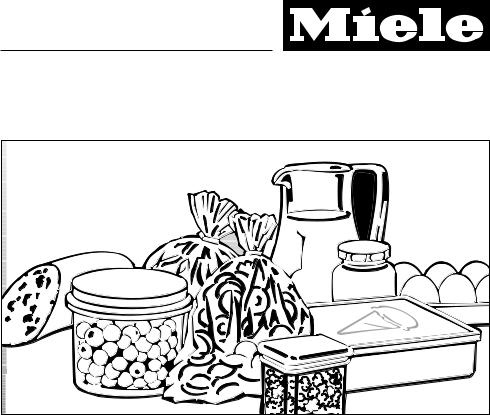
Operating and installation instructions
Frost free fridge-freezer with PerfectFresh zone and ice cube maker KFN 14947 SDE ed
To avoid the risk of accidents or |
en - GB |
damage to the appliance, it is |
|
essential to read these instructions |
|
before it is installed and used for the |
|
first time. |
M.-Nr. 07 849 810 |

Contents
Guide to the appliance . . . . . . . . . . . . . . . . . . . . . . . . . . . . . . . . . . . . . . . . . . . . . 5
Caring for the environment . . . . . . . . . . . . . . . . . . . . . . . . . . . . . . . . . . . . . . . . . . 7
Warning and Safety instructions . . . . . . . . . . . . . . . . . . . . . . . . . . . . . . . . . . . . . 8
How to save energy . . . . . . . . . . . . . . . . . . . . . . . . . . . . . . . . . . . . . . . . . . . . . . . 13
Switching on and off . . . . . . . . . . . . . . . . . . . . . . . . . . . . . . . . . . . . . . . . . . . . . . 14 Operating the appliance . . . . . . . . . . . . . . . . . . . . . . . . . . . . . . . . . . . . . . . . . . . . 14 Switching on . . . . . . . . . . . . . . . . . . . . . . . . . . . . . . . . . . . . . . . . . . . . . . . . . . . . . 14 Switching off . . . . . . . . . . . . . . . . . . . . . . . . . . . . . . . . . . . . . . . . . . . . . . . . . . . . . 15 To switch the refrigerator section/PerfectFresh zone or freezer section on or off separately . . . . . . . . . . . . . . . . . . . . . . . . . . . . . . . . . . . . . . . . . . . . . . . . . . . . . 15 Switching off for longer periods of time . . . . . . . . . . . . . . . . . . . . . . . . . . . . . . . . . 16 Settings mode . . . . . . . . . . . . . . . . . . . . . . . . . . . . . . . . . . . . . . . . . . . . . . . . . . . . 17 Switching the sensor tone on/off. . . . . . . . . . . . . . . . . . . . . . . . . . . . . . . . . . . . 17 Activating or deactivating the safety lock. . . . . . . . . . . . . . . . . . . . . . . . . . . . . 18
The correct temperature . . . . . . . . . . . . . . . . . . . . . . . . . . . . . . . . . . . . . . . . . . . 19
. . . in the refrigerator and the PerfectFresh zone . . . . . . . . . . . . . . . . . . . . . . . . . 19 Dynamic cooling . . . . . . . . . . . . . . . . . . . . . . . . . . . . . . . . . . . . . . . . . . . . . . . . . . 19
. . . in the freezer section . . . . . . . . . . . . . . . . . . . . . . . . . . . . . . . . . . . . . . . . . . . . 19 Setting the temperature . . . . . . . . . . . . . . . . . . . . . . . . . . . . . . . . . . . . . . . . . . . . . 20 Temperature range . . . . . . . . . . . . . . . . . . . . . . . . . . . . . . . . . . . . . . . . . . . . . . 20 Temperature display . . . . . . . . . . . . . . . . . . . . . . . . . . . . . . . . . . . . . . . . . . . . . . . 21 Setting the temperature in the PerfectFresh zone . . . . . . . . . . . . . . . . . . . . . . . . . 21 Changing the temperature display brightness . . . . . . . . . . . . . . . . . . . . . . . . . 22
Alarm. . . . . . . . . . . . . . . . . . . . . . . . . . . . . . . . . . . . . . . . . . . . . . . . . . . . . . . . . . . 23 Temperature alarm . . . . . . . . . . . . . . . . . . . . . . . . . . . . . . . . . . . . . . . . . . . . . . . . 23 Door alarm . . . . . . . . . . . . . . . . . . . . . . . . . . . . . . . . . . . . . . . . . . . . . . . . . . . . . . . 24
Super cool and Super freeze . . . . . . . . . . . . . . . . . . . . . . . . . . . . . . . . . . . . . . . 25 Super cool . . . . . . . . . . . . . . . . . . . . . . . . . . . . . . . . . . . . . . . . . . . . . . . . . . . . . . . 25 Super freeze . . . . . . . . . . . . . . . . . . . . . . . . . . . . . . . . . . . . . . . . . . . . . . . . . . . . . 26
Using the refrigerator efficiently . . . . . . . . . . . . . . . . . . . . . . . . . . . . . . . . . . . . 27 Different storage zones . . . . . . . . . . . . . . . . . . . . . . . . . . . . . . . . . . . . . . . . . . . . . 27 Food which should not be stored in a refrigerator. . . . . . . . . . . . . . . . . . . . . . . . . 28 When shopping for food . . . . . . . . . . . . . . . . . . . . . . . . . . . . . . . . . . . . . . . . . . . . 28 Storing food correctly . . . . . . . . . . . . . . . . . . . . . . . . . . . . . . . . . . . . . . . . . . . . . . 28
Unpacked meat and vegetables . . . . . . . . . . . . . . . . . . . . . . . . . . . . . . . . . . . 28

Contents
Using the PerfectFresh zone . . . . . . . . . . . . . . . . . . . . . . . . . . . . . . . . . . . . . . . 29 Storage temperature . . . . . . . . . . . . . . . . . . . . . . . . . . . . . . . . . . . . . . . . . . . . . . . 29 Humidity level . . . . . . . . . . . . . . . . . . . . . . . . . . . . . . . . . . . . . . . . . . . . . . . . . . . . 29 Storing food in the PerfectFresh zone compartments . . . . . . . . . . . . . . . . . . . . . . 29
Adjusting the interior fittings . . . . . . . . . . . . . . . . . . . . . . . . . . . . . . . . . . . . . . . 31 Moving the shelves . . . . . . . . . . . . . . . . . . . . . . . . . . . . . . . . . . . . . . . . . . . . . . . . 31 Split shelf . . . . . . . . . . . . . . . . . . . . . . . . . . . . . . . . . . . . . . . . . . . . . . . . . . . . . . . . 31 Adjusting the condiment tray/bottle shelf . . . . . . . . . . . . . . . . . . . . . . . . . . . . . . . 32 Universal container . . . . . . . . . . . . . . . . . . . . . . . . . . . . . . . . . . . . . . . . . . . . . . . . 33 Moving the bottle divider . . . . . . . . . . . . . . . . . . . . . . . . . . . . . . . . . . . . . . . . . . . . 33
Freezing and storing food . . . . . . . . . . . . . . . . . . . . . . . . . . . . . . . . . . . . . . . . . . 34 Maximum freezing capacity. . . . . . . . . . . . . . . . . . . . . . . . . . . . . . . . . . . . . . . . . . 34 Freezing fresh food . . . . . . . . . . . . . . . . . . . . . . . . . . . . . . . . . . . . . . . . . . . . . . . . 34 Storing frozen food . . . . . . . . . . . . . . . . . . . . . . . . . . . . . . . . . . . . . . . . . . . . . . . . 34 Home freezing . . . . . . . . . . . . . . . . . . . . . . . . . . . . . . . . . . . . . . . . . . . . . . . . . . . . 35
Hints on home freezing. . . . . . . . . . . . . . . . . . . . . . . . . . . . . . . . . . . . . . . . . . . 35 Packing . . . . . . . . . . . . . . . . . . . . . . . . . . . . . . . . . . . . . . . . . . . . . . . . . . . . . . . 35 Before placing food in the freezer section . . . . . . . . . . . . . . . . . . . . . . . . . . . . 36 Placing food in the freezer section . . . . . . . . . . . . . . . . . . . . . . . . . . . . . . . . . . 36 Freezing large items . . . . . . . . . . . . . . . . . . . . . . . . . . . . . . . . . . . . . . . . . . . . . . . 36 Freezer calendar . . . . . . . . . . . . . . . . . . . . . . . . . . . . . . . . . . . . . . . . . . . . . . . . . . 36 Defrosting . . . . . . . . . . . . . . . . . . . . . . . . . . . . . . . . . . . . . . . . . . . . . . . . . . . . . . . 37 Cooling drinks . . . . . . . . . . . . . . . . . . . . . . . . . . . . . . . . . . . . . . . . . . . . . . . . . . . . 37 Cool pack. . . . . . . . . . . . . . . . . . . . . . . . . . . . . . . . . . . . . . . . . . . . . . . . . . . . . . . . 37
Making ice cubes . . . . . . . . . . . . . . . . . . . . . . . . . . . . . . . . . . . . . . . . . . . . . . . . . 38 Setting the water intake time for the ice cube maker . . . . . . . . . . . . . . . . . . . . . . 39
Defrosting . . . . . . . . . . . . . . . . . . . . . . . . . . . . . . . . . . . . . . . . . . . . . . . . . . . . . . . 41
Cleaning and care . . . . . . . . . . . . . . . . . . . . . . . . . . . . . . . . . . . . . . . . . . . . . . . . 42 Cleaning the outer casing, the interior and accessories . . . . . . . . . . . . . . . . . . . . 42 Cleaning the ice cube tray. . . . . . . . . . . . . . . . . . . . . . . . . . . . . . . . . . . . . . . . . . . 43 Ventilation gaps . . . . . . . . . . . . . . . . . . . . . . . . . . . . . . . . . . . . . . . . . . . . . . . . . . . 44 Door seal . . . . . . . . . . . . . . . . . . . . . . . . . . . . . . . . . . . . . . . . . . . . . . . . . . . . . . . . 44 Metal grille at the back of the appliance . . . . . . . . . . . . . . . . . . . . . . . . . . . . . . . . 44
Active charcoal filters . . . . . . . . . . . . . . . . . . . . . . . . . . . . . . . . . . . . . . . . . . . . . 45 To change the active charcoal filters. . . . . . . . . . . . . . . . . . . . . . . . . . . . . . . . . . . 45
Problem solving guide . . . . . . . . . . . . . . . . . . . . . . . . . . . . . . . . . . . . . . . . . . . . 47
Noises . . . . . . . . . . . . . . . . . . . . . . . . . . . . . . . . . . . . . . . . . . . . . . . . . . . . . . . . . 51

Contents
After Sales / Guarantee . . . . . . . . . . . . . . . . . . . . . . . . . . . . . . . . . . . . . . . . . . . . 52
Mains water connection . . . . . . . . . . . . . . . . . . . . . . . . . . . . . . . . . . . . . . . . . . . 53 Notes on connecting to the mains water supply . . . . . . . . . . . . . . . . . . . . . . . . . . 53 Connection to the water inlet . . . . . . . . . . . . . . . . . . . . . . . . . . . . . . . . . . . . . . . . . 53
Electrical connection. . . . . . . . . . . . . . . . . . . . . . . . . . . . . . . . . . . . . . . . . . . . . . 55
Installation . . . . . . . . . . . . . . . . . . . . . . . . . . . . . . . . . . . . . . . . . . . . . . . . . . . . . . 56 Location . . . . . . . . . . . . . . . . . . . . . . . . . . . . . . . . . . . . . . . . . . . . . . . . . . . . . . . . . 56 Climate range . . . . . . . . . . . . . . . . . . . . . . . . . . . . . . . . . . . . . . . . . . . . . . . . . . 56 Ventilation . . . . . . . . . . . . . . . . . . . . . . . . . . . . . . . . . . . . . . . . . . . . . . . . . . . . . . . 57 Installation . . . . . . . . . . . . . . . . . . . . . . . . . . . . . . . . . . . . . . . . . . . . . . . . . . . . . . . 57 Aligning the appliance . . . . . . . . . . . . . . . . . . . . . . . . . . . . . . . . . . . . . . . . . . . . . . 57 Appliance dimensions . . . . . . . . . . . . . . . . . . . . . . . . . . . . . . . . . . . . . . . . . . . . . . 58
Changing the door hinging . . . . . . . . . . . . . . . . . . . . . . . . . . . . . . . . . . . . . . . . . 59
Aligning the appliance doors . . . . . . . . . . . . . . . . . . . . . . . . . . . . . . . . . . . . . . . 69
Building in the appliance . . . . . . . . . . . . . . . . . . . . . . . . . . . . . . . . . . . . . . . . . . 70

Guide to the appliance
aOn sensor for the whole appliance and On/Off sensor for switching the refrigerator and freezer sections on and off separately
bSuper cool and Super freeze sensor
cSensor for setting a lower temperature ( )
dSafety lock indicator light
(only visible when the Safety lock is activated)
eTemperature display for the refrigerator and freezer sections
fSensor for switching between the refrigerator and the freezer sections (top = "Refrigerator" symbol; bottom = "Freezer" symbol)
gSensor for setting a higher temperature ( )
hAlarm off sensor
(only visible when the door or temperature alarm sounds)
iChange active charcoal filter indicator
(only visible when the active charcoal filters need to be changed)
5
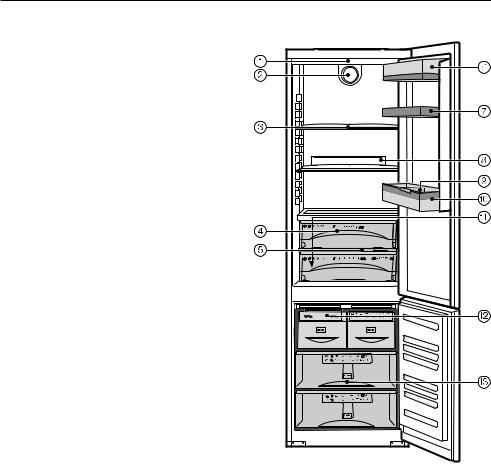
Guide to the appliance
aInterior lighting
bDynamic cooling fan
cAdjustable shelves
dPerfectFresh zone compartments
eControl for setting the humidity in the PerfectFresh zone compartments
fButter and cheese compartment
gEgg tray/Condiment tray
hActive charcoal filter holder
iBottle divider*
jBottle shelf
kCondensate channel and drain hole
lIce cube drawer with automatic ice cube maker
mFreezer drawers with freezer calendar
* Depending on model
6
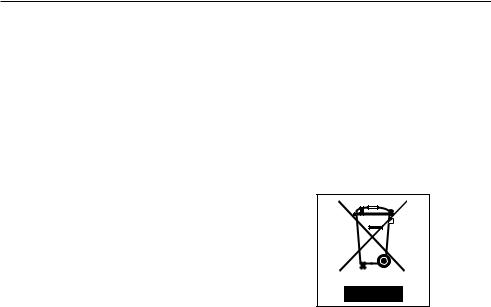
Caring for the environment
Disposal of the packing material
The transport and protective packing has been selected from materials which are environmentally friendly for disposal, and can normally be recycled.
Ensure that any plastic wrappings, bags etc. are disposed of safely and kept out of the reach of babies and young children. Danger of suffocation!
Rather than just throwing these materials away, please ensure that they are recycled.
Disposal of your old appliance
Electrical and electronic appliances often contain materials which, if handled or disposed of incorrectly, could be potentially hazardous to human health and to the environment. They are, however, essential for the correct functioning of your appliance. Please do not therefore dispose of it with your household waste.
Please dispose of it at your local community waste collection / recycling centre or contact your dealer for advice. Ensure that it presents no danger to children while being stored for disposal.
Take care not to damage the pipework at the back of it before or during transportation to an authorised collection depot.
In this way, refrigerant in the pipework and oil in the compressor will be contained, and will not leak out into the environment.
7

Warning and Safety instructions
This appliance complies with all relevant legal safety requirements. Improper use can, however, present a risk of both personal injury and material damage.
To avoid the risk of accidents and damage to the appliance, please read these instructions carefully before using it for the first time. They contain important notes on the installation, safety, operation and care of the appliance.
Keep these instructions in a safe place and pass them on to any future user.
Correct application
~ This appliance is not designed for commercial use. It is intended for use in domestic households and in similar working and residential environments such as:
–Shops
–Offices and showrooms
–Hostels and guest houses.
It must only be used as a domestic appliance to cool and store foodstuffs as well as to store deep frozen food, freeze fresh food and to prepare ice.
Any other usage is not supported by the manufacturer and could be dangerous. Miele cannot be held liable for damage resulting from incorrect or improper use or operation of the appliance.
~ This appliance is not intended for use by persons (including children) with reduced physical, sensory or mental capabilities, or lack of experience and knowledge, unless they are supervised whilst using it, or have been shown how to use it correctly by a person responsible for their safety.
Safety with children
~ This appliance is not a toy! To avoid the risk of injury, do not allow children to play with it or near it, or to play with the controls. Neither should they be allowed to climb in drawers or swing on the doors.
Please supervise young children whilst you are using it.
Older children may only use the appliance when its operation has been clearly explained to them and they are able to use it safely, recognising the dangers of misuse.
8
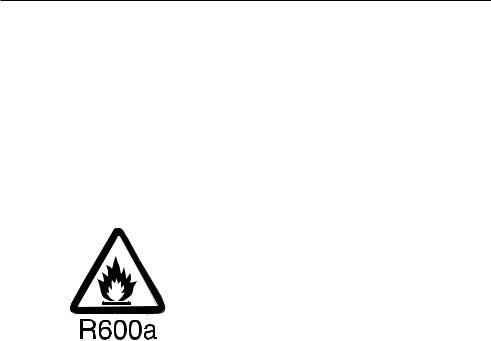
Warning and Safety instructions
Technical safety
~Before setting up the appliance, check it for any externally visible damage. Do not install and use a damaged appliance.
A damaged appliance could be dangerous.
~If the connection cable is faulty it must only be replaced by a service technician authorised by the manufacturer to protect the user from danger.
~ This appliance contains the coolant Isobutane (R600a), a natural gas which is environmentally friendly. Although it is flammable, it does not damage the ozone layer and does not increase the greenhouse effect. The use of this coolant has, however, led to a slight increase in the noise level of the appliance. In addition to the noise of the compressor, you might be able to hear the coolant flowing around the system. This is unavoidable, but does not have any adverse effect on the performance of the appliance.
Care must be taken during the transportation and installation of the appliance that no parts of the cooling system are damaged. Leaking coolant can damage the eyes.
In the event of any damage:
- avoid open flames and anything which
creates a spark,
-disconnect from the mains,
-air the room in which the appliance is located for several minutes and
-contact the Service Department for advice.
~The more coolant there is in an appliance, the larger the room it should be installed in. In the event of a leakage, if the appliance is in a small room, there is the danger of
combustible gases building up.
For every 8 g of coolant at least 1 m3 of room space is required. The amount of coolant in the appliance is stated on the data plate inside the appliance.
~Safe operation of the appliance is only assured if it has been installed and connected in accordance with these operating and installation instructions.
~Before connecting the appliance, make sure that the connection data on the data plate (voltage and connected load) match the mains electricity supply.
This data must correspond in order to avoid the risk of damage to the appliance. Consult a qualified electrician if in any doubt.
~Do not connect the appliance to the mains electricity supply by a multi-socket unit or an extension lead. These do not guarantee the required safety of the appliance (e.g. danger of overheating).
9

Warning and Safety instructions
~The electrical safety of this appliance can only be guaranteed when continuity is complete between it and an effective earthing system which complies with current local and national safety regulations. It is most important that this basic safety requirement is present and tested regularly, and where there is any doubt, the household wiring system should be inspected by a qualified electrician. The manufacturer cannot be held liable for damage or injury caused by the lack of or inadequacy of an effective earthing system (e.g. electric shock).
~Installation, maintenance and repairs may only be carried out by a suitably qualified and competent person in strict accordance with current national and local safety regulations. Repairs and other work by unqualified persons could be dangerous. The manufacturer cannot be held liable for unauthorised work.
~While the appliance is under guarantee, repairs should only be undertaken by a service technician authorised by the manufacturer. Otherwise the guarantee will be invalidated.
~ The appliance must be isolated from the electricity supply during installation, maintenance and repair work.
The appliance is only completely isolated from the electricity supply when:
–it has been switched off at the wall socket and the plug has been withdrawn, or
–the fuse from the fused spur connection unit has been withdrawn, or
–the mains fuse has been disconnected,
–or the screw out fuse has been removed in countries where this is applicable.
~Faulty components must only be replaced by genuine Miele original spare parts. The manufacturer can only guarantee the safety of the appliance when Miele replacement parts are used.
~This appliance may only be used in mobile installations such as ships, if a risk assessment of the installation has been carried out by a suitably qualified engineer.
10

Warning and Safety instructions
~The manufacturer cannot be held liable for damage caused by a faulty connection to the mains water supply.
~Connection to the mains water supply and any repairs to the ice cube maker must only be carried out by a suitably qualified and competent person.
~The ice cube maker is not suitable for connection to a hot water supply.
~In countries where there are areas which may be subject to infestation by cockroaches or other vermin, pay particular attention to keeping the appliance and its surroundings in a clean condition at all times. Any damage which may be caused by cockroaches or other vermin will not be covered by the guarantee.
~Before making plumbing connections, ensure the appliance is disconnected from the mains electricity supply.
Correct use
~Never handle frozen food with wet hands. Your hands may freeze to the frozen food or to the metal. Danger of frost burn.
~Do not take ice cubes out with your bare hands and never place ice cubes or ice lollies in your mouth straight from the freezer.
The very low temperature of the frozen ice or lollies can cause frost burn to the lips and tongue.
~Do not refreeze thawed or partially thawed food. Defrosted food should be used up as quickly as possible, as food
soon loses its nutritional value and goes off. Defrosted food may only be re-frozen after it has been cooked.
~Do not store explosive materials in the appliance or any products containing propellants (e.g. spray cans). Thermostats switching on may produce sparks which could present a fire hazard. Flammable compounds could explode.
~Do not operate any electrical equipment (e.g. an electric ice-cream maker) inside the appliance. Danger of sparking and explosion.
~If storing alcohol with a high percentage proof in the refrigerator zone, make sure it is tightly closed and stored upright.
~Do not store cans or bottles containing carbonated drinks or liquids which could freeze in the freezer. The cans or bottles could explode. Danger of injury and damage to the appliance.
~When cooling drinks quickly in the freezer, make sure bottles are not left in for more than one hour; otherwise they could burst, Danger of injury and damage to the appliance.
~Observe the "use-by" dates given on food to avoid the risk of food poisoning. Storage times will depend on several factors, including the freshness and quality of the food as well as the temperature at which it is stored. Follow the instructions given on the food manufacturer's packaging regarding storage conditions and "use-by" dates.
11

Warning and Safety instructions
~ Do not use sharp edged objects to
–remove frost and ice,
–separate frozen foods and remove ice trays.
They will damage the evaporator, causing irreversible damage to the appliance.
~Never place electric heaters or candles in the appliance to defrost it. These can damage the plastic parts.
~Do not use defrosting sprays or de-icers, as they might contain substances which could damage the plastic parts or which could cause a build-up of gases and pose a danger to health.
~Do not use any oils or grease on the door seals, as these will cause the seals to deteriorate and become porous with time.
~If storing food which contains a lot of fat or oil, make sure that it does not come into contact with plastic components as this could cause stress cracks.
~Do not block the ventilation gaps in the appliance as this would impair the efficiency of the appliance, increase the electricity consumption and could cause damage to the appliance.
~The appliance is designed for use within certain climate ranges (ambient temperatures), and should not be used outside this range. The climate range for your appliance is stated on the data plate inside the appliance.
Installing it in a room with too low an ambient temperature, e.g. a garage, can lead to the appliance switching off for longer periods so that it cannot maintain the required temperature.
~Do not use a steam-cleaning appliance to defrost or clean this appliance. Steam could reach the electrical components and cause a short circuit.
Disposal of your old appliance
~Before disposing of an old appliance, first make the door latch or lock unusable.
This way you will prevent children from accidentally locking themselves in and endangering their lives.
~Be careful not to damage any part of the pipework whilst awaiting disposal, e.g. by
–puncturing the refrigerant channels in the evaporator.
–bending any pipework.
–scratching the surface coating.
Splashes of refrigerant can damage the eyes.
The manufacturer cannot be held liable for damage caused by non-compliance with these Warning and safety instructions.
12
|
|
How to save energy |
|
|
|
|
|
|
Normal energy |
|
Increased energy |
|
|
||
|
consumption |
|
consumption |
|
|
|
|
|
|
|
|
Installation site |
In a ventilated room. |
|
In an enclosed, unventilated room. |
|
|
|
|
|
Protected from direct sunlight. |
|
In direct sunlight. |
|
|
|
|
|
Not situated near to a heat source |
|
Situated near to a heat source |
|
(radiator, oven). |
|
(radiator, oven). |
|
|
|
|
|
Where the ideal ambient room |
|
Where there is a high ambient |
|
temperature is approx. 20°C. |
|
room temperature. |
|
|
|
|
|
|
|
|
Temperature setting with |
With a medium setting of 2 to 3. |
|
With a high setting: the lower the |
a thermostat which is |
|
|
temperature in the compartment, |
approximate |
|
|
the higher the energy |
(set in stages). |
|
|
consumption. |
|
|
|
|
|
|
|
|
Temperature setting with |
Cellar section 8 to 12°C |
|
|
a thermostat which is |
|
|
On appliances with winter setting, |
Refrigerator section 4 to 5 °C |
|
||
exact to the degree |
|
please make sure that the winter |
|
|
|
||
(digital display). |
PerfectFresh zone just above 0 °C |
|
setting is switched off when the |
|
|
|
ambient temperature is warmer |
|
Freezer section -18°C |
|
|
|
|
than 16 °C. |
|
|
|
|
|
|
|
|
|
|
Wine storage section 10 to 12 °C |
|
|
|
|
|
|
|
|
|
|
Use |
Only open the doors when |
|
Frequent opening of the doors for |
|
necessary and for as short a time |
|
long periods will cause a loss of |
|
as possible. |
|
coldness. |
|
|
|
|
|
Store food in an organised way. |
|
If food is not stored in an |
|
|
|
organised way, searching for an |
|
|
|
item will mean the door is open for |
|
|
|
longer. |
|
|
|
|
|
Allow hot food and drinks to cool |
|
Placing hot food in the appliance |
|
down before placing them in the |
|
will cause the compressor to run |
|
appliance. |
|
for a long time, as the appliance |
|
|
|
will have to work harder to lower |
|
|
|
the temperature. |
|
|
|
|
|
Store food covered or packaged. |
|
The evaporation or condensation |
|
|
|
of liquids will cause a loss of |
|
|
|
coldness in the refrigerator. |
|
|
|
|
|
Place frozen food in the |
|
|
|
refrigerator to defrost. |
|
|
|
|
|
|
|
Do not over-fill the appliance to |
|
|
|
allow air to circulate. |
|
|
|
|
|
|
|
|
|
|
Defrosting |
Defrost the freezer compartment |
|
A layer of ice hinders the cold |
|
when a layer of ice 0.5 cm thick |
|
from reaching the frozen food, and |
|
has built up. |
|
causes an increase in energy |
|
|
|
consumption. |
|
|
|
|
13

Switching on and off
Before using for the first time
The stainless steel external and internal surfaces of the appliance have a layer of protective foil to prevent scratching during transportation.
^Do not remove this foil until the appliance has been installed or built in.
^After removing the protective foil, treat stainless steel surfaces with a suitable stainless steel conditioning agent (available from www.miele-shop.com).
Important: Stainless steel conditioner gives long lasting protection, and helps to prevent resoiling.
^Clean the inside of the appliance and the accessories with lukewarm water and a little washing-up liquid, and then dry with a soft cloth.
Important:
To ensure the correct functioning of the appliance, let it stand for between 1½ and 2 hours after transporting it to its final location before connecting it to the mains.
Active charcoal filters (Active AirClean filters)
^Place the active charcoal filters supplied in the holder, and place the holder on one of the refrigerator shelves (see "Active charcoal filters").
Operating the appliance
A light touch of the finger on the sensors is all that is required to operate this appliance.
Switching on
The refrigerator section/PefectFresh zone and freezer sections are switched on together with the On/Off sensor.
^Touch the On/Off sensor until the temperature display lights up.
The temperature display for the refrigerator section will show the current temperature in the refrigerator section.
If the temperature in the freezer section is above 0 °C, only bars will light up in the temperature display for the freezer section. As soon as the temperature is below 0 °C, the temperature display for the freezer section will show the current temperature in the freezer section.
The "Freezer" symbol and the Alarm off sensor will flash until the temperature in the freezer section has cooled down to the correct temperature for freezing.
The appliance will start to cool, and the interior lighting will come on when the refrigerator section door is opened.
14
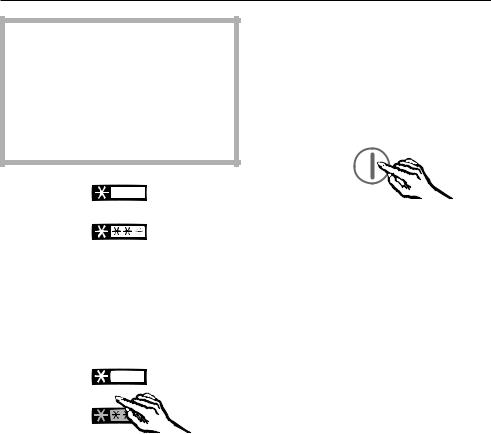
Switching on and off
To enable the temperature to get sufficiently cold inside the appliance, allow the appliance to run for a few hours before placing food in it.
Do not place food in the freezer section until the temperature is at least -18°C.
This sensor is used to switch between the refrigerator and freezer sections.
If you want to select the freezer section (to check the temperature, for example),
^touch the sensor for selecting the freezer/refrigerator section until the "Freezer" symbol lights up yellow.
Depending on which section you have selected, you can
–select either Super cool or Super freeze, or
–adjust the temperature.
Please refer to the relevant section for more information.
Cool pack
Place the cool pack in the top freezer drawer. The cool pack will be at its most effective after it has been in the freezer for approx. 24 hours.
Switching off
^Touch the On/Off sensor until all of the indicators go out. (If this does not happen, the safety lock is still activated).
The refrigerator section/PerfectFresh zone and freezer section will switch off one after the other.
The interior lighting will not come on when you open the door and the cooling process will be switched off.
To switch the refrigerator section/PerfectFresh zone or freezer section on or off separately
The refrigerator section/PerfectFresh zone and the freezer section can be switched on or off separately, if you should only wish to use one section. This is useful, e.g. whilst on holiday, if you only want to leave the freezer section switched on:
15
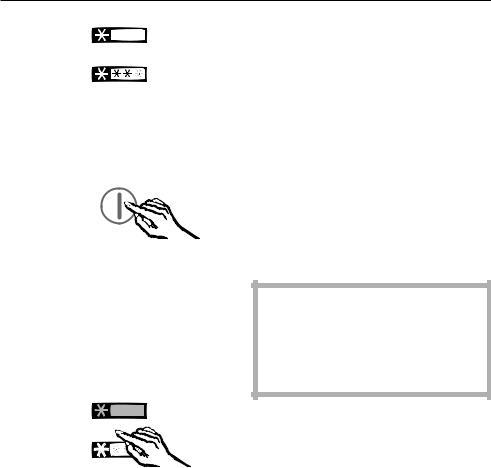
Switching on and off
^Select the section of the appliance which you wish to switch off.
The "Refrigerator" or the "Freezer" symbol will light up yellow.
^Touch the On/Off sensor until the "Refrigerator" or the "Freezer" symbol goes out.
The section you selected is now switched off while the other section remains switched on.
To switch a section back on again:
^Select the section which you want to switch on. The relevant symbol will light up yellow.
^Touch the On/Off sensor until the temperature display lights up, or
^Switch the appliance off and then back on again.
Switching off for longer periods of time
If the appliance is not going to be used for a longer period of time, e.g. whilst on holiday:
^switch the appliance off,
^switch off at the wall socket and withdraw the plug,
^empty and clean the ice cube tray,
^close the stopcock for the water inlet,
^clean the appliance out and
^leave the appliance doors ajar to air the appliance.
If, during a long absence, the appliance is switched off but not cleaned out and the doors are left shut, there is a danger of mould and odours building up inside the appliance.
16
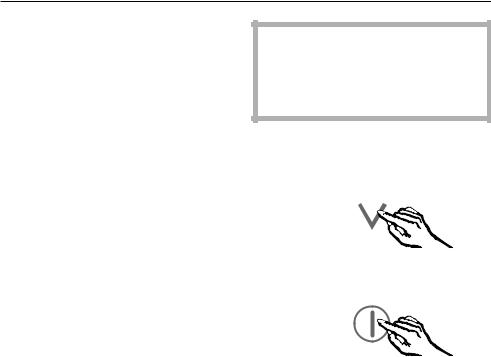
Switching on and off
Settings mode
Certain settings on the appliance can only be selected in the settings mode.
How to select the settings mode and how to change the settings is described in the relevant section of these instructions.
Overview of functions that can be selected in the settings mode:
|
|
To enter or leave the settings |
|
mode |
c |
|
|
|
|
To switch the sensor tone |
|
on/off |
b |
(see "Switching on and off") |
|
|
|
To confirm that the active |
|
charcoal filters have been |
|
changed (see "Active charcoal |
^ |
|
|
filters") |
|
|
|
To switch the safety lock on/off |
|
(see "Switching on and off") |
u |
|
|
|
|
To change the brightness of |
|
the temperature display |
|
(see "The correct |
d |
|
|
temperature") |
|
|
|
To adjust the temperature in |
|
the PerfectFresh zone |
|
(see "The correct |
§ |
|
|
temperature") |
|
|
|
To set the water intake time for |
|
the ice cube maker |
e |
(see "Making ice cubes") |
|
|
|
|
|
The door alarm is automatically disabled when the appliance is in the settings mode. As soon as the door is closed, the door alarm is activated again.
Switching the sensor tone on/off
The tone which sounds each time a sensor is touched can be deactivated.
^Touch and leave your finger on the sensor.
^At the same time, briefly touch the On/Off sensor (without letting go of the sensor).
^Leave your finger on the sensor for another 5 seconds until c appears in the display.
^Touch the sensor repeatedly until b appears in the display.
^Touch the On/Off sensor.
^By touching the sensor, you can now select whether the sensor tone is switched on or off:
b 0: Sensor tone is switched off b 1: Sensor tone is switched on b –: Return to menu
17

Switching on and off
The old setting lights up, and your newly selected setting flashes.
^Touch the On/Off sensor to confirm the new setting.
^Touch the sensor repeatedly until c appears in the display.
^Touch the On/Off sensor.
You have now left the settings mode.
Activating or deactivating the safety lock
The safety lock can be activated to prevent the appliance being switched off inadvertently.
^Touch and leave your finger on the sensor.
^At the same time, briefly touch the On/Off sensor (without letting go of the sensor).
^Leave your finger on the sensor for another 5 seconds until c appears in the display.
^Touch the sensor repeatedly until u appears in the display.
^Touch the On/Off sensor.
^By touching the sensor, you can now select whether the safety lock is switched on or off:
u 0: The safety lock is deactivated
u 1: The safety lock is activated u –: Return to menu
The old setting lights up, and your newly selected setting flashes.
^Touch the On/Off sensor to confirm the new setting.
^Touch the sensor repeatedly until c appears in the display.
^Touch the On/Off sensor.
You have now left the settings mode.
The safety lock indicator X will light up in the temperature display when the safety lock has been activated.
18

The correct temperature
It is very important to set the correct temperature for storing food in the appliance. Micro-organisms will cause food which is not stored at the correct temperature to deteriorate rapidly. Temperature influences the growth rate of these micro-organisms. Reducing the temperature reduces their growth rate.
The temperature in the appliance will rise:
–the more often the door is opened and the longer it is kept open,
–the more food that is stored in it,
–the warmer the food is which is being put into it,
–the higher the ambient temperature surrounding the appliance.
The appliance is designed for use in specific ambient temperatures (climate ranges). Do not use in ambient temperatures for which it is not designed.
. . . in the refrigerator and the PerfectFresh zone
We recommend a temperature of 4 °C in the middle of the refrigerator.
The temperature in the PerfectFresh zone is controlled automatically, and is maintained at 0 to 3 °C.
Dynamic cooling
The dynamic cooling fan automatically switches on when the cooling system for the refrigerator switches on. It distributes the temperature in the appliance to all areas evenly so that all the food will be chilled to about the same degree.
. . . in the freezer section
To freeze fresh food and to store frozen food for a long time, a temperature of -18 °C is required. At this temperature the growth of micro-organisms is generally halted. As soon as the temperature rises above -10 °C, the micro-organisms become active in the food again so that it cannot be kept as long. For this reason, partially defrosted or defrosted food must not be re-frozen. Food may be re-frozen once it has been cooked, as the high temperatures achieved when cooking destroy most micro-organisms.
19

The correct temperature
Setting the temperature
The temperatures in the refrigerator section/PrefectFresh zone and freezer section are set independently of one another.
^Select the refrigerator or the freezer section.
The "Refrigerator" symbol or the "Freezer" symbol will light up yellow.
^You can now use the arrow sensors on either side of the temperature display to set the temperature you require.
By touching the
sensor: the temperature will get colder
sensor: the temperature will get warmer.
The temperature being set will flash in the display.
The following information shows in the display when the sensors are touched:
–Touching a sensor once: the last temperature selected flashes.
–Each subsequent touch of a sensor: adjusts the temperature shown in
1 °C steps.
–Leaving a finger on the sensor: changes the temperature continuously.
When the highest or lowest temperature in the range is reached, the or sensor disappears.
Approx. 5 seconds after taking your finger off a sensor, the average, current temperature of the refrigerator or freezer section is automatically shown.
If you have adjusted the temperature, wait for approx. 6 hours if the appliance is not very full and for approx. 24 hours if the appliance is full before checking the temperature display, as it will take this long for the display to give an accurate reading. If, after this time, the temperature is still too high or too low, you will need to adjust it again.
Temperature range
The temperature can be adjusted:
–In the refrigerator section from 3 °C to 9 °C
–In the freezer section from -14 °C to -28 °C
The ambient temperature in the room and the installation location can affect the time it takes for the appliance to reach the lowest temperature. If the ambient temperature is too high, the appliance may not reach the lowest temperature.
20
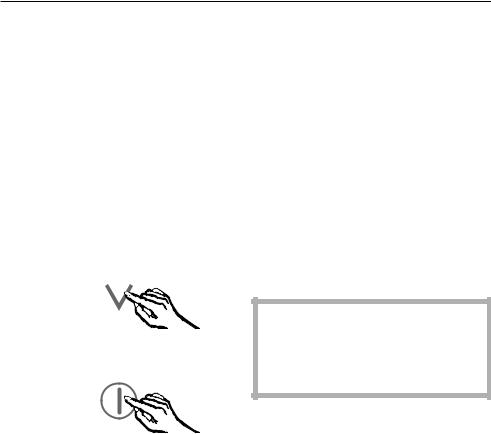
The correct temperature
Temperature display
During normal operation the temperature display on the control panel shows the temperature in the middle of the refrigerator section or the temperature in the warmest part of the freezer section.
Setting the temperature in the PerfectFresh zone
The temperature in the PerfectFresh zone is automatically held at 0 to 3 °C. It can be raised or lowered, e.g. if you want to use it for storing items like fish.
^Touch and leave your finger on the sensor.
^At the same time, briefly touch the On/Off sensor (without letting go of the sensor).
^Leave your finger on the sensor for another 5 seconds until c appears in the display.
^Touch the sensor repeatedly until § appears in the display.
^Touch the On/Off sensor.
^You can now adjust the temperature in the PerfectFresh zone by touching the sensor. You can choose from settings 1 to 9:
§1: Lowest temperature,
§9: Highest temperature.
§–: Return to menu.
The old setting lights up, and your newly selected setting flashes.
^Touch the On/Off sensor to confirm a new setting.
^Touch the sensor repeatedly until c appears in the display.
^Touch the On/Off sensor.
You have now left the settings mode.
§ 5 is the default setting for the PerfectFresh zone. If a setting of § 1 to § 4 is selected, the temperature can fall below 0°C. Food could freeze!
21

The correct temperature
Changing the temperature display brightness
The temperature display brightness can be adjusted to suit the lighting conditions of the room.
^Touch and leave your finger on the sensor.
^At the same time, briefly touch the On/Off sensor (without letting go of the sensor).
^Leave your finger on the sensor for another 5 seconds until c appears in the display.
^Touch the sensor repeatedly until d appears in the display.
^Touch the On/Off sensor.
^The temperature display brightness can now be changed by touching thesensor:
d 0: Maximum brightness d 1: Reduced brightness d –: Return to menu.
The old setting lights up, and your newly selected setting flashes.
^Touch the On/Off sensor to confirm a new setting.
^Touch the sensor repeatedly until c appears in the display.
^ Touch the On/Off sensor.
You have now left the settings mode.
22
